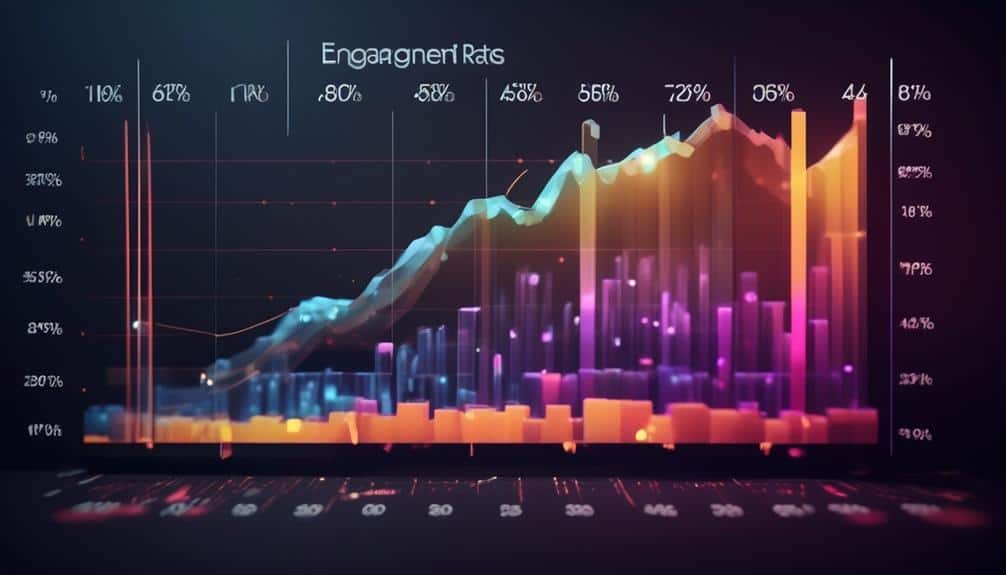Beyond Views and Likes: Advanced Metrics for Content ROI Analysis
When it comes to measuring the success of your content, it's like peeling back the layers of an onion – there's more depth than what meets the eye.
Beyond the surface-level metrics of views and likes lie a realm of advanced analytics waiting to be explored. Imagine unraveling the true impact of your content efforts, understanding the intricacies that go beyond mere numbers.
As you venture into the realm of advanced metrics for content ROI analysis, you'll discover a whole new landscape of insights that can revolutionize your approach to content strategy.
Key Takeaways
- Utilize quantitative and qualitative metrics for comprehensive content analysis
- Implement targeted keyword strategies and conduct A/B testing for optimization
- Analyze audience demographics to tailor content for better engagement
- Track user behavior, conversion rates, and revenue attribution for informed decision-making
Audience Engagement Metrics

To effectively measure the impact of your content on audience engagement, utilize a combination of quantitative and qualitative metrics that provide a comprehensive understanding of user interaction. User interaction is a key indicator of how well your content resonates with your audience. By delving into engagement analytics, you can uncover valuable insights into how users are interacting with your content, including likes, comments, shares, and time spent on page. Quantitative metrics such as click-through rates and conversion rates offer concrete data points, while qualitative metrics like sentiment analysis and feedback surveys provide a deeper understanding of user preferences and behaviors.
Engagement analytics allow you to track user interactions at a granular level, enabling you to optimize your content strategy for maximum impact. By analyzing these metrics, you can identify trends, patterns, and areas for improvement, ultimately enhancing the overall user experience. Remember, user interaction isn't just about numbers; it's about forging meaningful connections with your audience and creating content that resonates with them on a personal level.
Conversion Rate Optimization
You are about to explore the pivotal aspects of Conversion Rate Optimization, focusing on Click-Through Rate strategies and A/B Testing results.
These elements will provide critical insights into enhancing your content's effectiveness in converting visitors into leads or customers.
Click-Through Rate Strategies
Implementing targeted keyword strategies can significantly enhance click-through rates, a crucial aspect of Conversion Rate Optimization. To boost your strategy, consider the following:
- Keyword Research: Utilize tools to find high-performing keywords for your ads or emails.
- Ad Copy Optimization: Craft compelling and relevant ad copy to entice clicks.
- A/B Testing: Experiment with different keywords and messaging to identify the most effective combinations.
- Email Subject Lines: Test variations to see which keywords drive higher open rates.
- Landing Page Alignment: Ensure that keywords used in ads or emails align with the landing page content for a seamless user experience.
A/B Testing Results
In analyzing A/B testing results for Conversion Rate Optimization, the data reveals compelling insights into the effectiveness of different variations. Content segmentation plays a crucial role in understanding user behavior and how different segments engage with various content types.
By carefully analyzing A/B test results, you can pinpoint which content resonates best with specific user segments, leading to improved conversion rates. User behavior data gathered from A/B tests allows you to make data-driven decisions on what content types are most effective in driving conversions.
This insight enables you to tailor your content to different user segments more effectively, ultimately maximizing your Conversion Rate Optimization efforts. Embracing these insights from A/B testing can significantly enhance the overall performance of your content strategy.
Social Media Reach Analysis

When evaluating your content's performance on social media platforms, understanding the reach metrics is crucial. Utilize reach measurement tools to quantify the number of unique users exposed to your content.
Calculate engagement rates to gauge the level of interaction and interest among your audience.
Analyzing the demographics of your social media audience can provide valuable insights for targeted content strategies.
Reach Measurement Tools
Utilizing sophisticated data analytics, social media reach analysis tools provide invaluable insights into the extent of your content's audience reach and engagement. When considering your reach measurement tools, here are some key aspects to focus on:
- Audience Segmentation: Identify different audience segments reached by your content.
- Engagement Tracking: Monitor how your audience interacts with your content.
- Competitor Benchmarking: Compare your reach metrics with competitors for strategic insights.
- Real-time Analytics: Access up-to-the-minute data on your content's reach performance.
- Cross-Platform Integration: Analyze reach across various social media platforms for a holistic view.
Engagement Rate Calculation
Having analyzed the reach of your content through sophisticated tools, the next step is to calculate the engagement rate to gauge the effectiveness of your social media strategy.
To determine this crucial metric, you need to employ precise engagement rate calculation methods. By dividing the total number of interactions (likes, comments, shares) by the total reach and multiplying by 100, you can obtain your engagement rate.
Once calculated, it's essential to compare your engagement rate with industry benchmarks to assess performance accurately. Tracking engagement rate trends over time provides valuable insights into the effectiveness of your content strategy.
Utilizing these metrics allows you to make data-driven decisions and optimize your social media approach for increased audience interaction and brand visibility.
Audience Demographics Analysis
To understand the composition of your audience and enhance your social media reach strategy, conducting an in-depth analysis of audience demographics is imperative. By delving into user segmentation and behavior analysis, you can uncover valuable insights to optimize your content strategy effectively.
Here's how you can leverage audience demographics analysis:
- Demographic Breakdown: Identify age, gender, location, and other key demographic factors.
- Interest Mapping: Understand the interests and preferences of different audience segments.
- Engagement Patterns: Analyze how various demographics engage with your content.
- Purchase Behavior: Explore the buying habits and patterns of different demographic groups.
- Content Personalization: Tailor your content to resonate with specific audience segments for increased engagement and conversions.
Content Performance Tracking
For a comprehensive understanding of how your content is performing, analyze key metrics that provide valuable insights into its impact and effectiveness. Content relevance evaluation allows you to gauge how well your content aligns with your target audience's interests and needs. Tracking user behavior, such as time spent on page and click-through rates, gives you a deeper insight into how engaging and compelling your content is to your audience. Performance benchmarking against industry standards and competitor analysis can help you identify areas for improvement and innovation in your content strategy. ROI analysis is crucial in determining the effectiveness of your content in achieving your business goals and objectives. By leveraging advanced metrics and data analytics, you can optimize your content performance and ensure that your efforts are yielding measurable results.
| Metrics | Insights |
|---|---|
| Content Relevance | Audience alignment |
| User Behavior Tracking | Engagement levels |
| Performance Benchmarking | Industry comparison |
| ROI Analysis | Business impact measurement |
| Competitor Analysis | Strategic improvement opportunities |
SEO Impact Assessment
Analyze the SEO impact of your content through comprehensive assessment of key metrics and data analytics to determine its effectiveness in driving organic search visibility and traffic. Understanding the nuances of SEO impact assessment is crucial for optimizing your content strategy.
Here are some key points to consider:
- Keyword Performance: Evaluate how well your content ranks for target keywords and identify opportunities for improvement.
- Backlink Analysis: Assess the quality and quantity of backlinks to your content to gauge its authority and relevance to search engines.
- Organic Traffic Fluctuations: Monitor fluctuations in organic traffic to understand the impact of algorithm changes or content updates.
- Click-Through Rates: Analyze CTR data to optimize meta tags and descriptions for higher click-through rates from search results.
- Content Engagement Metrics: Measure user behavior metrics like bounce rate and time on page to enhance content relevance and user experience.
Revenue Attribution Models

Utilize advanced revenue attribution models to accurately measure the monetary impact of your content marketing efforts and make informed decisions on resource allocation and strategy optimization. By understanding how different touchpoints contribute to conversions along the customer journey, multi-touch attribution provides a more comprehensive view of how your content influences revenue generation.
With the customer journey becoming increasingly complex, relying solely on last-click attribution can lead to undervaluing the impact of certain content pieces. Multi-touch attribution allows you to assign credit to various interactions a customer has with your content before making a purchase, giving you a clearer picture of what drives revenue.
Implementing multi-touch attribution models enables you to optimize your content strategy by identifying which pieces are most effective at different stages of the customer journey. This data-driven approach empowers you to allocate resources more efficiently, focusing on content that drives the most significant revenue impact. By leveraging advanced revenue attribution models, you can enhance your content ROI analysis and drive better outcomes for your marketing efforts.
Frequently Asked Questions
How Can We Measure the Emotional Impact of Our Content on Our Audience?
To measure the emotional impact of your content on your audience, consider measuring engagement through sentiment analysis. Analyze reactions, comments, and shares to gauge emotional responses. Utilize data-driven insights to understand how your content resonates with your audience.
Are There Any Specific Tactics for Improving Conversion Rates on Mobile Devices?
To improve conversion rates on mobile devices, focus on user experience and design. Optimize for mobile, enhance engagement. Implement responsive design, fast load times, clear calls to action. Analyze data to refine strategies continuously for better results in mobile optimization.
How Can We Accurately Track the Reach of Our Social Media Content Across Different Platforms?
To accurately track your social media content's reach across platforms, employ cross-platform tracking tools like Audience segmentation for precise insights. Evaluate Engagement rates and Sentiment analysis to decode audience interactions effectively and optimize content strategy for maximum impact.
What Are Some Effective Strategies for Monitoring and Optimizing the Performance of Specific Types of Content, Such as Videos or Blog Posts?
To monitor and optimize content performance effectively, focus on engagement strategies and content personalization. Utilize data analysis for audience segmentation. By tailoring content to specific demographics, you can enhance engagement and drive better ROI.
What Are Some Key Indicators to Look for When Assessing the Impact of SEO Efforts on Content Performance and Roi?
When assessing the impact of SEO efforts on content performance and ROI, you should look for key indicators like emotional engagement metrics and conversion optimization rates. These insights can provide valuable data for enhancing your content strategy.
Conclusion
In conclusion, by incorporating advanced metrics beyond views and likes, businesses can gain a deeper understanding of their content ROI. Audience engagement metrics, conversion rate optimization, social media reach analysis, content performance tracking, SEO impact assessment, and revenue attribution models provide valuable insights for optimizing content strategies and maximizing returns.
By leveraging these metrics effectively, businesses can make data-driven decisions that drive growth and success in the digital landscape.








